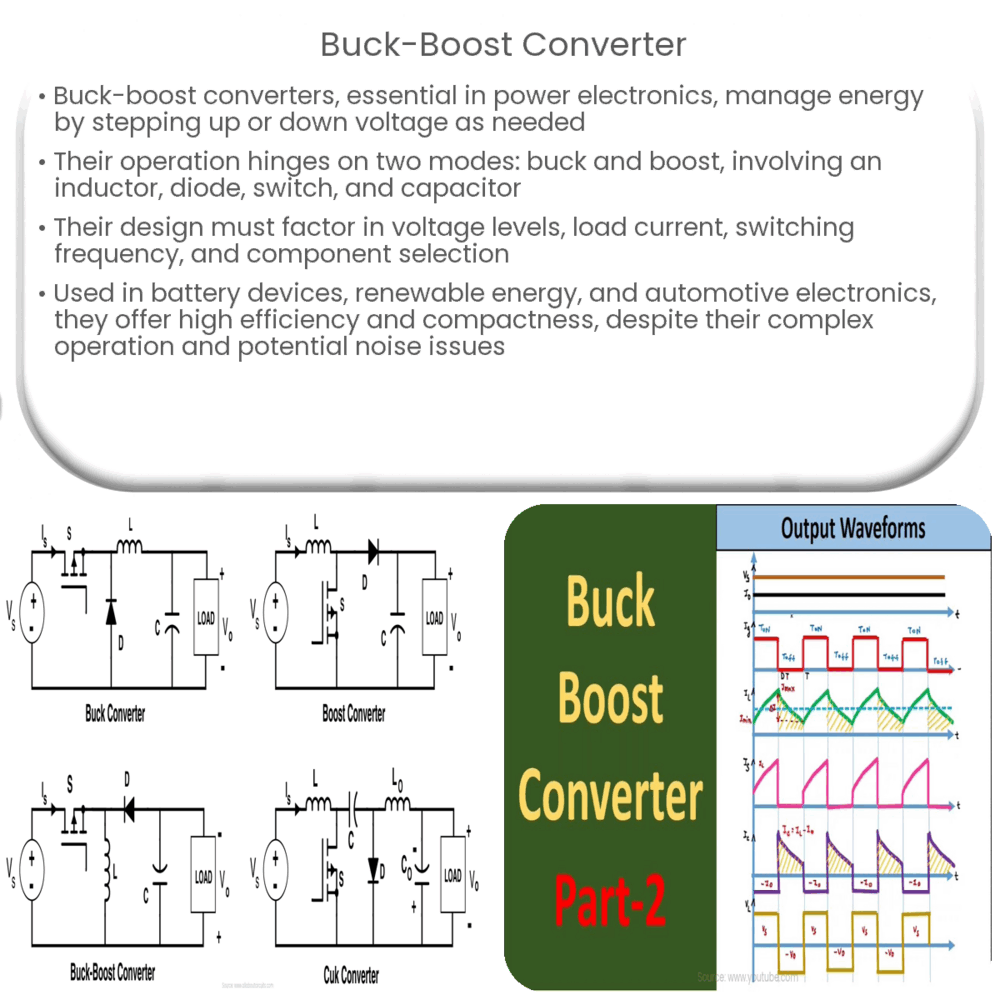Buck-boost converters efficiently regulate voltage levels in power electronics by stepping up or down input voltage to meet load requirements.

Buck-Boost Converter: An Essential Power Conversion Technique
Introduction
A buck-boost converter is an essential tool in the field of power electronics, often employed to efficiently manage energy flow in various applications. This converter offers a versatile solution to power regulation, as it can step up or step down voltage levels according to the requirements of the load. In this article, we will delve into the working principle, design aspects, and applications of buck-boost converters.
Working Principle
The basic operation of a buck-boost converter can be understood by analyzing its two distinct modes: the buck mode, where the output voltage is lower than the input voltage, and the boost mode, where the output voltage is higher than the input voltage. This converter operates by switching between these two modes, thus controlling the output voltage as needed.
A buck-boost converter primarily consists of an inductor, a diode, a switch (usually a transistor), and a capacitor. The switch is used to alternate between the two modes, while the inductor and capacitor store energy during each mode, ensuring a smooth output voltage.
Buck Mode
When the switch is closed in the buck mode, the input voltage is directly connected to the inductor, causing the current to flow through it and store energy. At the same time, the diode is reverse-biased, preventing current from flowing through it. The capacitor releases energy stored from previous cycles to the load, maintaining a continuous output voltage.
Boost Mode
When the switch is opened in the boost mode, the inductor’s energy is released to the capacitor and load. Since the inductor and input voltage are connected in series, their voltages add up, resulting in a higher output voltage. The diode is forward-biased during this mode, allowing current to flow from the inductor to the capacitor and load.
Design Considerations
Designing an efficient buck-boost converter involves considering several factors, such as the input and output voltage levels, load current, switching frequency, and component selection. For instance, a higher switching frequency allows for the use of smaller inductors and capacitors, reducing the overall size of the converter. However, higher frequencies may also increase switching losses, affecting the converter’s efficiency.
Component selection is crucial in determining the converter’s performance. Choosing an inductor with the right value ensures that it can store sufficient energy during each mode without saturating, while selecting a suitable capacitor helps maintain a stable output voltage with minimal ripple. Additionally, the diode and switch must be chosen based on their voltage and current ratings to ensure reliable operation.
Applications
Buck-boost converters are widely used in various applications, including:
- Battery-operated devices, where the converter manages the voltage levels for optimal battery life and performance
- Renewable energy systems, such as solar panels or wind turbines, to regulate the generated power
- Automotive electronics, for voltage regulation in electric and hybrid vehicles
Advantages and Disadvantages
There are several advantages to using buck-boost converters in power conversion applications:
- Versatility: The ability to step up or step down the input voltage makes buck-boost converters suitable for a wide range of applications.
- High efficiency: By minimizing power losses during conversion, buck-boost converters can offer efficiency levels up to 95% or higher.
- Compact size: Due to the use of smaller components at higher switching frequencies, these converters can be designed with a minimal footprint.
However, there are also some disadvantages to consider:
- Complexity: The operation of a buck-boost converter is more complex than that of a simple buck or boost converter, which may lead to more complicated control schemes and a higher likelihood of errors.
- Increased noise: Switching at high frequencies can generate electromagnetic interference (EMI) and increase noise levels, which may require additional filtering and shielding measures.
Non-Isolated and Isolated Buck-Boost Converters
Buck-boost converters can be classified into two types: non-isolated and isolated.
Non-isolated buck-boost converters: In this configuration, the input and output grounds are directly connected, providing no electrical isolation between the input and output sides. Non-isolated converters are typically more straightforward and cost-effective but may not be suitable for applications requiring safety or noise isolation.
Isolated buck-boost converters: These converters incorporate a transformer to electrically isolate the input and output grounds, providing safety and noise isolation benefits. However, isolated converters are typically more complex and expensive compared to their non-isolated counterparts.
Conclusion
Buck-boost converters play a vital role in various power conversion applications by offering the flexibility to step up or step down voltage levels as required. Their versatile nature, high efficiency, and compact design make them an attractive solution for a wide range of industries, including consumer electronics, renewable energy systems, and automotive applications. However, it is essential to carefully consider the design aspects, component selection, and potential trade-offs to ensure optimal performance and reliability.

